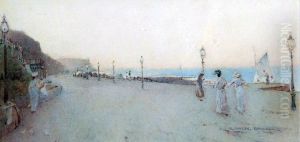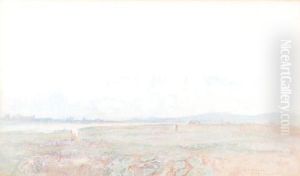Henry Dawson Barkas Paintings
Henry Dawson Barkas was an English artist and illustrator, born in 1880. Although not as widely known as some of his contemporaries, Barkas made a significant contribution to the early 20th century British art scene, particularly in the realms of illustration and graphic design. His work, characterized by its detailed realism and often whimsical subjects, captured the imagination of a generation looking for escapism in the aftermath of the First World War.
Barkas received his artistic training at the Royal College of Art in London, where he developed a keen interest in both traditional painting techniques and the emerging styles of the early 20th century. This dual influence is evident in his work, which often blends classical themes with a modernist sensibility. After completing his studies, he embarked on a career as a freelance illustrator, contributing to various magazines and periodicals of the time. His illustrations were known for their meticulous attention to detail and vibrant storytelling, making them popular with a wide audience.
Beyond illustration, Barkas also explored painting, with several of his works exhibited in prestigious galleries throughout the United Kingdom. These paintings, often landscapes and portraits, showcased his versatility as an artist and his ability to capture the subtle nuances of light and color. Despite his success, Barkas remained relatively out of the spotlight, preferring the quietude of his studio to the bustling art scene of London.
The interwar period was a time of great experimentation for Barkas, as he delved into various artistic movements and explored new techniques. However, it was also a time of personal challenge, as the economic hardships of the era made it difficult for artists to find steady work. Barkas navigated these challenges with resilience, continuing to produce work that resonated with both critics and the general public.
Henry Dawson Barkas passed away in 1951, leaving behind a legacy of artistic innovation and a body of work that continues to be appreciated by art historians and collectors alike. Though he may not have achieved the fame of some of his peers, his contributions to the field of illustration and British art are undeniable. Today, his work is celebrated for its creativity, craftsmanship, and unique perspective on the early 20th century world.

